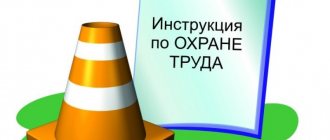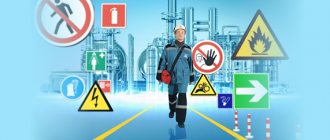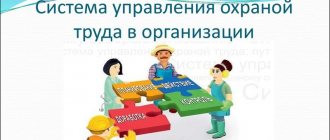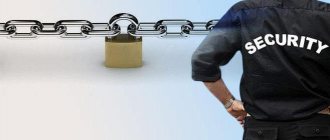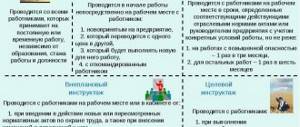Normative base
Public control over labor protection at an enterprise is regulated by Article 370 of the Labor Code of the Russian Federation. The functions of controllers, who must constantly monitor compliance with the terms of collective agreements, employment contracts, other agreements and regulations (LLA), are assigned to trade unions. As part of such activities, they have the right to organize special inspections of trade unions, as well as to vest the necessary powers with their members. They approve the provisions that must guide inspectors, all-Russian trade unions and their associations. This supervisory activity is regulated by Federal Law No. 212 of July 21, 2014 “On the Fundamentals of Public Control in the Russian Federation.”
Organization of public control
The form of participation of trade unions in ensuring control over labor protection is multi-level:
- legal and technical public labor inspections of trade unions;
- authorized representatives of all-Russian trade unions;
- representatives of industry, regional (regional), district trade union associations;
- authorized representatives of primary trade union organizations directly in companies.
All authorized (trusted) persons are elected by open voting at a general meeting of a structural unit or at a trade union meeting of the organization’s employees.
At the enterprise, public control over labor protection is carried out:
- At specific workplaces in structural divisions.
- In departments, sections and workshops.
- In general for the enterprise.
The frequency of monitoring may vary depending on the location. Inspections of direct workplaces can be carried out randomly once a week, monitoring the work of departments is acceptable monthly, and a comprehensive audit of the organization is carried out once every six months or a year. The schedule is developed and approved by the chairman of the relevant trade union.
Example
Public control over labor protection in organizations protects the interests of the employee even in the event of labor disputes.
For example, the management of Khleboprodukty LLC delayed workers' wages for two weeks. A written appeal to the director signed by the chairman of the labor safety committee did not lead to results. The union appealed to the prosecutor's office, after which the wages were paid and the management of the enterprise was replaced.
Most often, trade unions are in contact with government authorities, and it is rare to represent the interests of workers in the courts. Issues of violation of working conditions, rest and payment of wages are most often resolved at the first time trade unions contact the authorities.
Occupational Safety and Health Commissioners
A department of authorized persons for labor protection can be created in almost any company. Moreover, the organizational and legal form, form of ownership and main economic activity do not matter. Also, administrative and public control over labor protection is in no way affected by departmental subordination, the number of employees, the presence of structural divisions, or the sectoral affiliation of an economic entity. Occupational safety and health must be present at any enterprise. The organization of labor protection depends on the specifics of production and is regulated by an internal LNA such as a production control program.
Key tasks of the commissioners:
- providing comprehensive assistance in a structural unit or organization as a whole in creating healthy, safe working conditions that comply with legal requirements;
- carrying out control measures to check the state of labor protection in a company or structural unit, monitoring compliance with the interests and rights of workers;
- representing the interests of workers in state or public organizations when considering labor conflicts and disputes regarding the employer’s fulfillment of its obligations;
- providing legal and legal advice on compliance with labor laws, providing other assistance to workers to protect their rights and interests.
Goals and objectives of trade union organizations in the field of labor protection
Supervisory authorities examine the implementation of administrative structures of labor protection standards. For these tasks, responsible persons are elected in departments and workshops. Trade union employees are actively working to protect the legitimate rights and interests of personnel. They also participate in a comprehensive study of the state of safety and security of activities at enterprises, institutions, and schools.
Levels of control over the implementation of labor protection measures
The union's specialists carry out a three-stage inspection and introduction into use of objects for household and industrial purposes. If there is an accident at work, they will investigate the situation. This also includes finding out the causes of occupational diseases.
Based on the standards of the UILK 161 society, responsible persons are elected at joint meetings. Some problems are discussed at the committee presidium. The issues of preparing an enterprise for winter work and providing special clothing are discussed.
Important! All ongoing activities are aimed at improving working conditions for employees and maintaining their health.
Rights of public inspectors
Labor inspectors and authorized persons for labor protection have the right:
- monitor employers' compliance with labor laws;
- conduct an independent examination of working conditions and ensuring the safety of workers;
- independently investigate, as well as participate in investigations conducted by management, occupational diseases and accidents at work;
- have up-to-date information about the state of working conditions and labor protection, as well as about all accidents (this must be provided by the management of organizations and individual entrepreneurs);
- protect workers from harm to their health and ensure protection of their activities;
- require employers to suspend work if it directly threatens the life and health of workers;
- require employers to eliminate all identified violations.
Employers are obliged not only to comply with such requirements of inspectors, but also to inform the relevant trade union body about the results within a week.
Main types of control of working conditions in the workplace
The main types of control in the workplace include:
- administrative and public control;
- departmental control;
- state control;
- public control.
Let us consider the features of each type of control of working conditions in the workplace in more detail.
Administrative and public control
Administrative and public control of working conditions in the workplace is of two types:
- 2-stage control;
- 3-speed (in some cases 4 or 5).
| stage | Who conducts it? | Frequency | What is being checked | results |
| 1st | Direct work supervisor | Every day before the start of the shift and during the shift | — state of workplaces; — serviceability of equipment, tools and devices; — operation of ventilation units; — condition of sanitary facilities; — availability of instructions and posters on labor protection; — availability and serviceability of personal protective equipment. | If violations are detected, measures are taken to eliminate them and an entry is made in the log. |
| 2nd | Head of a structural unit with a representative of the labor protection committee (commission), labor protection specialists | At least once a month, in accordance with the inspection schedule | — implementation of measures to eliminate deficiencies identified during the first stage of control; — serviceability and compliance of production and auxiliary premises, equipment, transport and lifting equipment with the requirements of safe operation; — timeliness of surveys and tests of protective equipment, equipment, lifting machines, vessels; — implementation of schedules for preventive inspections, repairs, etc.; — implementation of measures based on the results of certification of workplaces, etc.; | Detected deficiencies are eliminated and an entry is made in the journal. |
| 3rd | Occupational Safety and Health Commission | At least once a quarter | — implementation of measures to eliminate deficiencies identified during the II stage of control; — implementation of planned measures to improve working conditions and labor protection, including the measures of the “Occupational Safety and Health” section of the collective agreement, measures to respond to acts of accidents, as well as the implementation of orders, instructions, instructions on labor protection, regulations, control and supervisory authorities and recommendations committee (commission) on labor protection; — organizing training on labor protection for managers and specialists of the organization; — organization of medical examinations and other treatment and preventive measures. | The results of the examination (check) are documented in the appropriate act |
Basic reporting documents on multi-stage control
The results of the 1st and 2nd stages of monitoring the state and conditions of labor protection are recorded in journals of the established form.
Log form for the 1st level of control Log form for the 2nd level of control
The results of checking the state of working conditions at the 3rd stage of control are documented in a corresponding act. Let's consider the main design features of this document.
Main sections of the act:
- Comments and violations identified during the inspection. This section describes the identified violations with references to regulations governing this issue.
- Recommendations for eliminating violations. This section prescribes specific measures that must be taken by the contractor to eliminate violations.
- Deadline for eliminating violations.
- Responsible for eliminating violations.
- Evaluation of inspection results. In this section, the commission gives a general assessment of the results of the inspection, as well as the work of the manager on ensuring safe conditions in the workplace.
Rules for drawing up the act:
- the act is signed by all members of the commission that conducted the inspection;
- the act must be approved by the head of the organization;
- the act must indicate the date of its approval and assign a number;
- all responsible and interested persons must be familiarized with the act (under signature);
- Photo and video recording materials based on the results of the inspection can be attached to the act.
Form of the 3rd stage of control act
Attention! For large production organizations related to the operation of equipment, transport, tools, etc. It is recommended to carry out 3 or 4 stage control. For small and medium-sized enterprises (up to 200 people), 2-stage control is applicable.
Departmental control
Departmental control of the state of labor protection in the workplace is carried out by a higher organization.
This type of control is carried out during comprehensive inspections of subordinate organizations, during targeted inspections of the state of labor protection, as well as upon statements from employees of subordinate organizations.
State control
State control of the state and conditions of labor protection is carried out by:
- Federal Labor Inspectorate;
- federal executive authorities (Rostechnadzor, Rospotrebnadzor, etc.).
Supervision over the implementation of laws in force on the territory of the Russian Federation is carried out by the Prosecutor's Office of the Russian Federation.
Public control
According to Art. 370 of the Labor Code of the Russian Federation, trade unions have the right to monitor the employer’s compliance with the requirements of labor legislation.
To exercise control, the trade union at the meeting elects a labor protection representative from the workforce.
This person carries out regular inspections of working conditions at workplaces. Based on the results of the inspection, the authorized person draws up a Representation of the authorized person for labor protection - a document that indicates the identified violations and proposals for their elimination.
Occupational Safety and Health Commissioner Representation Form
The employer must eliminate the violations within a week and inform the trade union about the measures taken.
The Occupational Safety and Health Commissioner is usually a member of the Occupational Safety and Health Commission.
Functions and powers
Authorized control bodies not only have rights, but are also endowed with corresponding powers and functions. The key goal is supervision of the employer’s activities in full and strict compliance with labor discipline in relation to employees. Also, authorized representatives must monitor employees to see whether they are coping with their responsibilities to fulfill and ensure occupational safety requirements.
To achieve key goals, controllers perform the following functions:
- check compliance by employees of the organization with norms, instructions, regulations and rules on occupational safety;
- control the correct use of personal and collective protective equipment by employees, if it is necessary to use them (this means the use of special clothing, shoes, and other personal protective equipment for their intended purpose, keeping the protective equipment in proper cleanliness and order);
- participate as official representatives of workers in the work of specially created commissions to carry out control measures and examine the technical condition of buildings and structures, equipment, instruments, machines, mechanisms and other objects for compliance with their labor protection standards and rules. Check the efficiency and serviceability of ventilation shafts and systems, sanitary equipment and sanitary facilities, the maintenance of personal and collective protective equipment for employees, and also develop measures aimed at eliminating identified deficiencies;
- develop and implement measures aimed at preventing work-related injuries, accidents and occupational diseases, as well as improving working conditions for workers;
- promptly inform managers about accidents that have occurred, monitor compliance with working time and rest time standards, provide guarantees, compensation and benefits for working conditions that deviate from normal;
- organize training in providing first aid to victims of industrial accidents, and help provide it directly in the event of an accident;
- participate in the investigation of industrial accidents that have already occurred on behalf of a trade union body or other representative body of the labor collective;
- inform workers about violations regarding safety requirements during work, carry out explanatory work in the team on labor protection issues.
Supervision and control of labor protection
From this article you will learn what types of supervision and control over occupational safety exist, which bodies of supervision and control over occupational safety in Russia implement them in practice, get acquainted with a short list of their main powers, and learn how an occupational safety inspection is carried out.
The organization of safe work, supervision and control in the field of labor protection in all divisions of the enterprise is assigned to the appropriate service. To do this, occupational safety specialists:
1. Check regularly:
• condition of equipment, territory, structures; • correct maintenance of occupational safety documentation; • availability of PPE and its adequate use by employees; • the quality of occupational safety training and the use of safe work practices by employees;
2. Analyze existing and possible hazards, keep records of safety and health conditions, participate in the certification and certification of workplaces, equipment, and production processes.
3. Compile lists of positions, types of work by departments that require occupational safety instructions.
4. Develop measures to prevent dangerous situations and reduce the impact of production hazards and hazards on workers.
5. Provide methodological assistance to health departments: provide them with instructions, rules, regulations, magazines, help draw up lists for medical examinations, personal protective equipment, provide benefits, etc.
6. Organize training for workers and engineers, participate in knowledge testing commissions.
7. Participate in the preparation of documentation: collective agreement, orders, instructions, coordinate and endorse projects, procedures, etc.
8. Participate in the work of commissions for the acceptance of equipment from repair, the commissioning of completed construction projects, the acceptance of workwear and personal protective equipment ordered from suppliers, etc.
9. Conduct introductory briefings.
10. Prepare and submit labor safety reports on time.
11. Supervise the use of funds from the organization’s OT fund.
12. Store OT documentation.
So that safety specialists can carry out supervision and control over labor protection in the units entrusted to them without hindrance, the occupational safety service reports to the head of the enterprise or his deputy with the corresponding job responsibilities. Therefore, other organizations have to check how this service copes with its responsibilities.
Documentation of control
The work of the labor safety inspector's public supervision must be properly recorded. For this purpose, the journal of administrative and public control on labor protection is used. The form of the document is not approved by any legal regulations and is therefore arbitrary. It can be independently developed and approved by the trade union committee of each organization. This document might look like this:
Who exercises control?
The organization must, by order of the manager, appoint persons responsible for control at the workplace.
Form of the Order on 3-stage control
As a rule, monitoring the state of labor protection at workplaces is carried out by:
- managers and specialists assigned with relevant functional responsibilities;
- occupational safety specialist/occupational safety service;
- labor protection commission;
- Occupational Safety and Health Commissioner from the workforce.
There are currently no requirements for the education or qualifications of the person responsible for control in the legislation.
Employer Responsibilities
Since public control is part of the work of the trade union movement, all employers are required to create conditions for public supervision inspectors to work in accordance with the collective agreement or local regulations of the organization. This means that the controller has the right:
- receive a release from the main job for at least 2 hours a week while maintaining payment for this time in the amount of average earnings;
- have access to the necessary documentation (rules, instructions, other regulatory and reference materials);
- freely visit the objects necessary for inspection;
- have conditions for processing and storing received documentation;
- undergo training at the expense of the employer and the Social Insurance Fund;
- have social guarantees.
For violation of the rights or obstruction of the work of a public representative, the employing organization itself and its officials bear responsibility in the manner established by the legislation of the Russian Federation.
